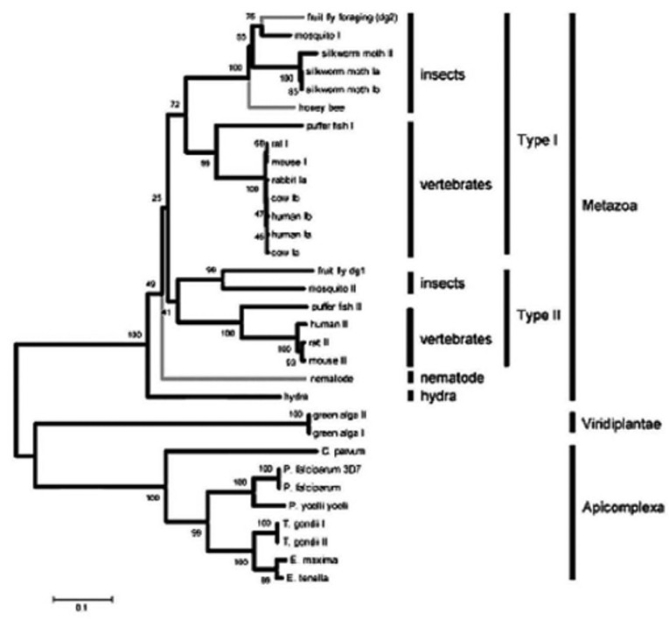Use the following information to answer the following question(s) .
The following are an abstract and figure from a paper that explores the evolutionary relationship between a protein kinase and behavior (M. Fitzpatrick and M. Sokolowski. 2004. In search of food: Exploring the evolutionary link between cGMP-dependent protein kinase (PKG) and behavior. Integrative and Comparative Biology 44:28-36) .
Abstract:
Despite an immense amount of variation in organisms throughout the animal kingdom, many of their genes show substantial conservation in DNA sequence and protein function. Here we explore the potential for a conserved evolutionary relationship between genes and their behavioral phenotypes. We investigate the evolutionary history of cGMP-dependent protein kinase (PKG) and its possible conserved function in food-related behaviors. First identified for its role in the foraging behavior of fruit flies, the PKG encoded by the foraging gene had since been associated with the maturation of behavior (from nurse to forager) in honey bees and the roaming and dwelling food-related locomotion in nematodes. These parallels encouraged us to construct protein phylogenies using 32 PKG sequences that include 19 species. Our analyses suggest five possible evolutionary histories that can explain the apparent conserved link between PKG and behavior in fruit flies, honey bees, and nematodes. Three of these raise the hypothesis that PKG influences the food-related behaviors of a wide variety of animals including vertebrates. Moreover it appears that the PKG gene was duplicated some time between the evolution of nematodes and a common ancestor of vertebrates and insects whereby current evidence suggests only the for-like PKG might be associated with food-related behavior.  These are neighbor joining trees that depict the evolutionary relationships of 32 PKG kinase domain and C-terminal amino acid sequences spanning 19 species of protozoans and metazoans. Values at the nodes represent the results of 5000 bootstrap replications. Lineages with known behavioral links with PKG are indicated by gray branches.
These are neighbor joining trees that depict the evolutionary relationships of 32 PKG kinase domain and C-terminal amino acid sequences spanning 19 species of protozoans and metazoans. Values at the nodes represent the results of 5000 bootstrap replications. Lineages with known behavioral links with PKG are indicated by gray branches.
-Using the figure and the accompanying paragraph, and knowing that the PKG encoded by the foraging gene has recently been associated with the maturation of out-of-nest behavior in honeybees, what would be a logical explanation for this relationship? As animals mature, they ________.
Definitions:
No-Trade Situation
A scenario in which countries or entities do not engage in international trade, often due to policies or barriers.
Domestic Price
The price of goods or services within a country's borders, distinct from international or foreign prices.
World Price
The global market price of a good or service, influenced by worldwide demand and supply.
Tariff
A tax imposed by a government on goods and services imported from other countries, often used to protect domestic industries from foreign competition.
Q2: Choose one of the universal cultural patterns
Q6: Which of the following will increase the
Q18: Describing other cultures in terms of the
Q19: Theoretically, which would be the most effective
Q22: Which of the following would explain why
Q22: How do carbohydrates contain and/or display information
Q29: Which of the following best represents the
Q41: Mechanoreceptors that react to changes in pressure
Q51: Lysosomes are considered to be part of
Q94: The birth control drug Mifepristone functions by